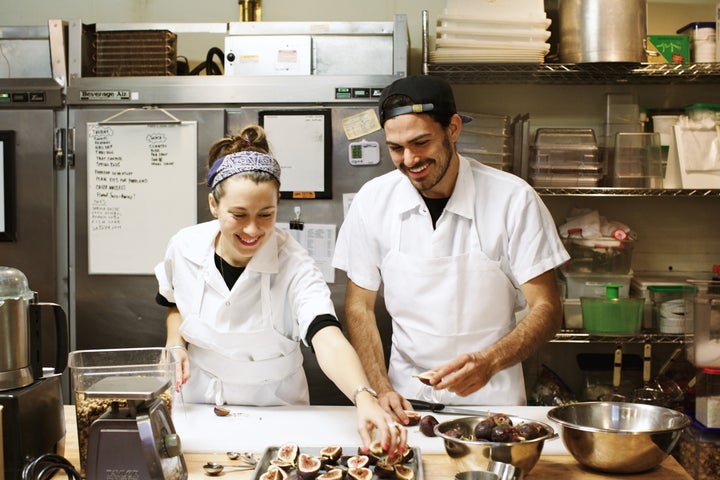
Ice cream is one of the sweetest ways to cool down when it’s hot out, but you may have noticed that the prices of the artisanal kind are rising as fast as the temperature.
Sure, you can get your fix at the supermarket, where you’ll spend about $4 for a tub of Breyers, but if you head to a small-batch scoop shop, you’ll spend around the same amount for just one scoop ($4.10 per scoop at Portland, Oregon-based Salt & Straw and $5.50 at Brooklyn-based Van Leeuwen Artisan Ice Cream). And you’ll pay double that for a pint ($9 at Salt & Straw, $10 at Van Leeuwen).
What gives?
Even compared to higher-end commercial brands like Häagen-Dazs ($5.19/pint) and Ben & Jerry’s ($4.79/pint), artisanal ice cream is significantly more expensive.
We’re using the term “artisanal” to encompass small-batch producers like Salt & Straw (which makes all of its ice creams by hand in 5-gallon batches), unlike commercial companies that churn out hundreds of gallons at a time. Ben & Jerry’s, for example, mixes its ice cream bases in a 1,000-gallon stainless steel blending tank.
If you’ve ever wondered why you’re paying so much more for artisanal ice cream, it comes down to three major factors: ingredients, processes and distribution. And they’re legitimate ― you’re not just paying for fancy flavors and pretty labels. Let’s break it down.
Ingredients: From bases to blueberries, premium ingredients cost significantly more.
At its core, ice cream is made with milk, cream and sugar. Companies can play with the amounts of these base ingredients, plus the amounts of overrun (the amount of air incorporated into the mixture), emulsifiers, stabilizers and mix-ins.
However, to legally call a product ice cream, it must satisfy certain standards outlined by the United States Department of Agriculture. Most notably, ice cream must weigh at least 4.5 pounds/gallon and contain at least 10 percent fat from milk. Take a closer look at this carton of Breyers and you’ll see it’s labeled as a “frozen dairy dessert,” not ice cream.

Exact compositions vary, but when comparing standard brands to their premium counterparts, there are some consistent variances, which are outlined in an ice cream ebook by Professor H. Douglas Goff of the University of Guelph in Ontario, Canada. The most expensive brands have the highest amount of fat (15 to 18 percent) and the lowest amount of overrun (25 to 50 percent), while economical brands often go as low as legal requirements permit: 10 percent fat and around 120 percent overrun.
One hundred percent overrun means that 50 percent of the resulting ice cream is mixture (milk and cream) and the other 50 percent is air, explains Kimberly Bukowski, a dairy foods extension specialist at Cornell University. Anything over 100 percent overrun means that the ice cream is more air than mixture.
Fat, meanwhile, is central to the texture and taste of ice cream. “Fat is the No. 1 thing you’re paying for, and that’s something you can’t fake,” Tyler Malek, head ice cream maker and co-founder of Salt & Straw, told HuffPost.
More fat means more interaction between fat molecules as the ice cream is mixed, which destabilizes the molecules and creates a larger structure that gives ice cream a smooth texture. “It’s this inner structure in your ice cream that is so velvety and it’s got that chew to it,” Malek says. “Your teeth will push through it in this way you can’t even explain, and that’s what great ice cream does for you.“
But fat (cream) is expensive, so you see less of it in mass-market brands. With less fat present, emulsifiers and stabilizers are especially needed to help bring the mixture together and maintain an ideal texture.
If you’ve ever wondered why you’re paying so much more for artisanal ice cream, it comes down to three major factors: ingredients, processes and distribution.
Van Leeuwen Artisan Ice Cream has a purist approach and only uses organic egg yolks as a natural stabilizer. Malek, on the other hand, sees value in using certain stabilizers like guar gum, xanthan gum and carrageenan at Salt & Straw ― but only when used appropriately. He draws the line when companies try to get away with using significantly less fat and compensating with stabilizers to “mimic all the fat texture with gums and enzymes that are stripping the fat in unnatural ways.”
Emulsifiers and stabilizers aren’t all bad, though, and Bukowski notes they are essential for ice creams that go through a distribution chain because they help maintain the product’s quality as temperatures change from the factory freezer to the truck and eventually the customer’s home.
Beyond the all-important ice cream base, working in small batches gives artisanal ice cream makers greater freedom to create unique flavors and use high-quality ingredients.
Van Leeuwen claims to use the best ingredients for every flavor, from Michel Cluizel chocolate from Normandy to pistachios grown on the slopes of a volcano in Sicily. Fresh ingredients like berries are sourced from Oregon, where they’re allowed to ripen completely and within hours of picking are processed into a puree and flash-frozen. All add-ins, such as honeycomb (broken by hand) and cookie dough (featuring uneven-sized chunks of bean-to-bar Askinosie chocolate made especially for Van Leeuwen) are made in-house, because it’s been a challenge to outsource production while still being able to incorporate these hand-selected ingredients.
“We’ll never compromise because we’re very sensitive to taste,” Ben Van Leeuwen told HuffPost. “We want things to be amazing.”
The Process: Different types of freezers affect how much ice cream you can make at a time.
Commercial producers make ice cream using continuous freezers, while artisanal makers use batch freezers. If you have no idea what those are, here’s the deal.
In continuous freezers, the ice cream mix is added to the machine, which can make an endless amount of batches as mixture goes in one end and ice cream comes out the other, Bukowski explains.

Batch freezers, on the other hand, can only make a set amount of ice cream at a time. Bukowski likens the batch freezer to a washing machine. Ingredients are added into the machine, which agitates and freezes the mix, and when the ice cream achieves the desired frozen state, it’s poured into containers.
Though the continuous freezer is more efficient, from a quality standpoint, it’s unclear which machine makes the better product.
“People have feelings on both, that you can get the best ice cream out of a continuous freezer and others feel you can get the best ice cream out of a batch freezer,” Bukowski says. She has experience working at a commercial ice cream company and later owned two ice cream shops, where she made her own product. “It just depends on what your preferences are. I think you can make great ice cream off of both.”
Distribution: Wholesome mom-and-pop service comes at a cost.
The brick-and-mortar method of selling ice cream by the scoop and the occasional pint comes with a set of inefficiencies and added costs (rent, employees to scoop ice cream, etc.) that are not present in the retail model, though shipping ice cream across long distances and managing large-scale distribution comes with its own costs and complications.
In terms of scaling up a business, however, it is a more straightforward process to increase wholesale than open more stores, Ben Van Leeuwen explained in an interview with The New Food Economy.
For companies like Van Leeuwen and Salt & Straw, the brick-and-mortar experience is central to brand identity. Salt & Straw releases a set of new flavors every four weeks, which follow a monthly theme and vary between stores.

“When you come into Salt & Straw, it’s going to be a completely different experience in Seattle versus Los Angeles,” Malek says. “It’s going to be this celebration of what’s going on at that moment in that one city and I think that’s really special.”
Considering all the elements that make artisanal ice cream more expensive, in the end, it all comes down to whether your taste buds can tell the difference to make it worth your money. And these artisanal brands are banking on the refinement of your taste buds.